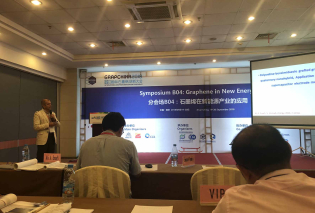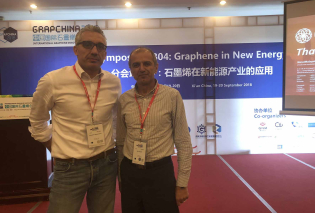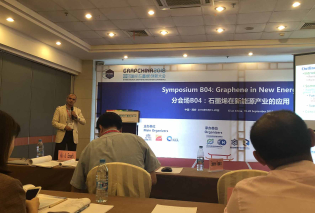Modification of graphene based materials for new energy sources
rnrnAli A. Ensafi
rnrna Department of Chemistry, Isfahan University of Technology, Isfahan 84156–83111, Iran; Fax: +98–31–33912350; Tel.: +98–31–33913269; E–mail: Ensafi@cc.iut.ac.ir, aaensafi@gmail.com
rnrnDue to increasing progress of modern portable electronic devices, the engineering of nanomaterials, in order to enhance their performance for responding to the industrial demand, has been an interesting topic for scientists. Among the different types of nanoparticles, porous hollow spheres are more interesting owing to the well-defined hollow interior, higher surface area, uniform shell thickness and short transport path length. This is due to the unique properties of low density, well-defined walls, high surface area and surface permeability [1]. In the last decade, ternary transition metal oxides with different metal cations, such as spinels, have appeared as a promising type of active materials for various electrochemical applications including lithium-ion batteries, supercapacitors, and electrocatalysts.
rnrnHere, we introduce different new electrochemical nanomaterials for hydrogen generation, water splitting, and supercapacitors based on modification of graphene with several new nanohybrids and nanocomposites materials. Some of them is based on bimetallic silicon nanostructures (Pt–M, M: Pd, Ru, Rh) on reduced graphene oxide (rGO), Pd#LDH/rGOs modified with some polymer layers as a hydrogen storage (Al-M/LDHs) modified reduced graphene oxide (rGO) and on RuO2-decorated exfoliated graphene oxide (RuO2-EGO), Pt-Pd nanoparticles decorated sulfonated graphene-poly(3,4-ethylene dioxythiophene) nanocomposite, [PW11MO39]5− decorated on Ru@rGO nanosheets, three-dimensional graphene promoted by palladium nanoparticles [1]. Recently, we have prepared Ni3S2/Ball-milled silicon flour and NiO nanoparticles decorated at Nile blue-modified reduced graphene oxide [2] as bi-functional electrocatalysts for hydrogen and oxygen evolution reactions (OER) and water splitting, sponge graphene network by (t-Bu)5[PW11CoO39] [3], thermally reduced graphene oxide/ploymelamine formaldehyde nanocomposite [4], onion-like nanoporous CuCo2O4 hollow spheres derived from bimetal-organic frameworks [5], and adenine decorated@reduced graphene oxide [6] as high capacitance supercapacitors. The nanocomposites and nanohybrids are characterized in detail using different electrochemical and spectroscopic methods. The nanohybrids exhibited excellent electrocatalysts for electrochemical hydrogen evolution reaction and water splitting with a small Tafel slope, which is one of the best candidates among all the or lower Pt and/or non-Pt electrocatalysts for electrochemical hydrogen evolution reaction with highly competitive performance relative to various hydrogen generation electrocatalytic materials such as MoS2 and WS2, and Pt. In addition, the isolated island architecture of the bi-functional as HER and OER electrocatalyst and onion-like bimetalic nanomaterials could act as the promising materials for supercapacitors.
rnrnReferences
rn[1] Ali A. Ensafi, E. Heydari-Soureshjani, B. Rezaei, Int. J. Hydrogen Energy, 2018, 43, 9652.
rnrn[2] Ali A. Ensafi, S.A. Sayed Afiuni, B. Rezaei, J. Electroanal. Chem., 2018, 816, 160.
rnrn[3] Ali A. Ensafi, E. Heydari-Soureshjani, B. Rezaei, Electrochim. Acta, 2018, in press.
rnrn[4] Ali A. Ensafi, H.A. Alinajafi and B. Rezaei, J. Mater. Chem. A, 2018, 6, 6045.
rnrn[5] Ali A. Ensafi, S.E. Moosavifard, B. Rezaei, S. Kamari Kaverlavani, J. Mater. Chem. A, 2018, 6,
rnrn10497.
rnrn[6] Ali A. Ensafi, H.A. Alinajafi and B. Rezaei, J. Alloys and Compounds, 2018, 735, 1010.
rnrnrn


